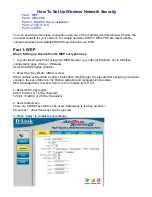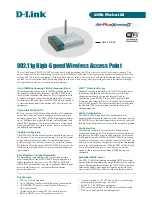
45
D-Link DAP-1665 User Manual
Section 3 - Configuration
Security
Mode:
802.11 Mode:
Wi-Fi Channel:
Transmission
Power:
Channel
Width:
HT20/40
Coexistence:
Visibility
Status:
Schedule:
Select the type of wireless security you wish to use for the
extended network. Choose from
WPA/WPA2-Personal
/
WPA/
WPA2-Enterprise/None
.
Select one of the following:
802.11n Only
- Select if you are only using 802.11n wireless
clients.
Mixed 802.11n and 802.11g -
Select if you are using a mix of
802.11n and 802.11g wireless clients.
Mixed 802.11n, 802.11g and 802.11b
- Select if you are using
a mix of 802.11n, 802.11g, and 802.11b wireless clients.
Choose from channels 1-11 for an existing wireless network or
to reduce interference in congested areas.
The
Auto
setting can be selected to allow the DAP-1665 to
automatically choose the channel with the least amount of
interference.
Depending on your wireless reception and coverage area, you
can choose between
Low, Medium,
or
High
power.
Select the Channel Width:
Auto 20/40
- Select if you are using both 802.11n and non-
802.11n wireless devices.
20 MHz
- Select if you are not using any 802.11n wireless clients.
Enable or disable HT20/40 coexistence by toggling the slider.
Enabling this feature helps with device compatibility depending
on their 802.11 version.
Select whether you would like the network name (SSID) of your
wireless network to be
Visible
or
Invisible
to wireless clients.
If
Invisible
, the SSID of the DAP-1665 will not be seen by site
survey utilities, so wireless clients will have to manually enter
the SSID of your wireless network in order to connect to it.
If you have added a rule under Management >> Schedule, click
on the drop-down menu to choose whether the device will
be
Always Enable
or choose from the name of your custom
schedule. Click
Save
to store the setting and the device will
reboot to activate the selected schedule.
Advanced Settings:
















































